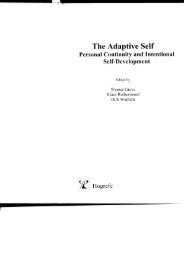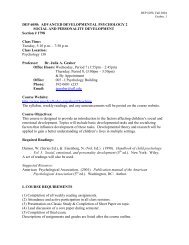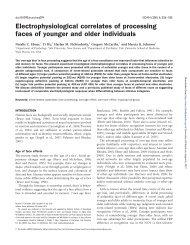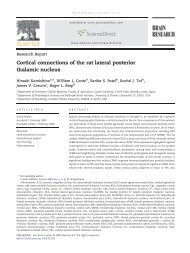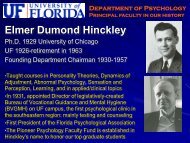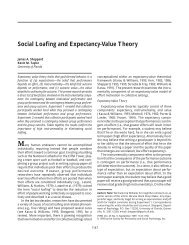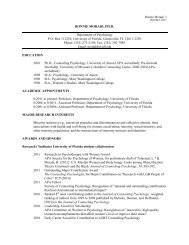Personality theories of successful aging - University of Florida ...
Personality theories of successful aging - University of Florida ...
Personality theories of successful aging - University of Florida ...
Create successful ePaper yourself
Turn your PDF publications into a flip-book with our unique Google optimized e-Paper software.
<strong>Personality</strong> Theories <strong>of</strong> Successful Aging<br />
9I<br />
,1987,\997) that (a) deind<br />
that developmental<br />
r gains and losses), and<br />
;es and outcomes serve<br />
rproach. This approach<br />
:r adaptive ways (M. M.<br />
re detail, we posit that<br />
ng the processes <strong>of</strong> suc-<br />
)06). Before elaboratino -a)<br />
bed the concept <strong>of</strong> per-<br />
:y in terms <strong>of</strong> three lev<strong>aging</strong>?<br />
To address this<br />
zli ty. F ollow ing Freund<br />
rn personality and sucs<br />
(1995,1996) compristiongl<br />
trnits. Traits are<br />
nonconditional disposhow<br />
considerable sta-<br />
;. Personal goals are a<br />
:rsonality descriptions<br />
ranisms, copi ng stra tertal,<br />
and strategic conre,<br />
place, and/or social<br />
they integrate and inrconstructed<br />
past, per-<br />
IcAdams (2001), most<br />
lives with unity, purolving<br />
life narratives,<br />
lemes. Level lll <strong>of</strong> perll,<br />
political, economic,<br />
oes the life story <strong>of</strong> a<br />
:vident in the notion<br />
n different contexts"<br />
all <strong>of</strong> these life narra-<br />
, points in life, chance<br />
llowing sections elab-<br />
:sonality traits, that is,<br />
and stable across time<br />
n <strong>of</strong> the stability argufor<br />
a s<strong>of</strong>ter version <strong>of</strong><br />
on personality traits<br />
refers to the identification <strong>of</strong> a universal structure <strong>of</strong> personality, individual differences,<br />
and the extent <strong>of</strong> longitudinal stability (Costa& McCrae, 7994,7995).<br />
There is consensus that personality can be well described by the Big Five personality<br />
traits: extraversion, agreeableness, conscientiousness, neuroticism, and<br />
openness to new experiences. These five factors have been identified by means <strong>of</strong><br />
factor analysis across various instruments and samples. Cross-sectional as well as<br />
longitudinal evidence on the structural invariance <strong>of</strong> the Big Five exists for adulthood<br />
and into old age (Costa& McCrae, 1994; Small , Hertzog, Hultsch, & Dixon,<br />
2003). Moreover, according to a meta-analysis by Roberts and DelVecchio (2000),<br />
the rank-order stability <strong>of</strong> the Big Five increases across the life span. These results<br />
were recently supplemented with regard to old and very old age by longitudinal<br />
<strong>aging</strong> studies (Mroczek & Spiro, 2003; Small et al., 2003).<br />
Contrary to some trait personality theorists' view that personality is "set like<br />
plaster" after the age <strong>of</strong> 30 (Costa& McCrae, 7994), cross-sectional as well as longitudinal<br />
evidence on mean levels <strong>of</strong> personality show changes in some <strong>of</strong> the Big<br />
Five characteristics across adulthood. Neuroticism, for example, decreases across<br />
adulthood (Mroczek & Spiro, 2003) and shows some increase again in very old<br />
age (Small et al., 2003). Moreover, in addition to becoming more neurotic, elderly<br />
people tend to become less open to new experiences and less extraverted (Costa,<br />
Herbst, McCrae, & Siegler, 2000), whereas they tend to become slightly more<br />
agreeable and conscientious (Helson & Kwan, 2000).<br />
Summarizing this empirical evidence based on trait as well as growth models <strong>of</strong><br />
personality clearly suggests that personality development in adulthood and old<br />
age is characterized by both stability and change. Regarding the relationship <strong>of</strong> the<br />
Big Five to subjective indicators <strong>of</strong> <strong>aging</strong> well, neuroticism is typically found to be<br />
negatively associated with measures <strong>of</strong> subjective well-being, whereas extraversion<br />
shows a positive relation to well-being. For instance, Isaacowitz and Smith (2003)<br />
demonstrated that in old and very old age (70 to 102 years), neuroticism is linked to<br />
higher negative and lower positive affect. The opposite pattern was found for extraversion<br />
(negative correlation with negative affect, positive correlation with positive<br />
affect). Note, however, that this pattern also holds for younger age groups (e.g., Diener.<br />
1984) and thus does not seem to constitute a deaelopmenfal phenomenon.<br />
Jurrrruc ro LEVEL III: PEnsoNal IpeNtttv<br />
In contrast to dispositional traits, life narratives are heavily influenced by specificities<br />
<strong>of</strong> the context and are subject to change across situations and time.<br />
McAdams (1990) argues that a unified or integrated life story, however, provides<br />
individuals with an identity and allows them to maintain a coherent self-concept<br />
across the entire life span (Cohen, 1998). Life stories are told to different audiences<br />
with different purposes: A life story told to a future spouse might look very<br />
different from the life story told to a future employer, not because the narrator<br />
becomes a different person in between the two events but because different aspects<br />
<strong>of</strong> a biography seem important and merit elaboration in these two contexts.<br />
According to McAdams, identity is not derived from one (veridical) life story but<br />
from the very act <strong>of</strong> meaning-making and integration <strong>of</strong> different aspects <strong>of</strong> a life<br />
into one coherent story (albeit possibly a different one each time it is told).<br />
The concept <strong>of</strong> autobiographical memories is closely related to the concept <strong>of</strong><br />
life stories (see also Habermas & Bluck, 2000). Some <strong>theories</strong> on autobiographical



